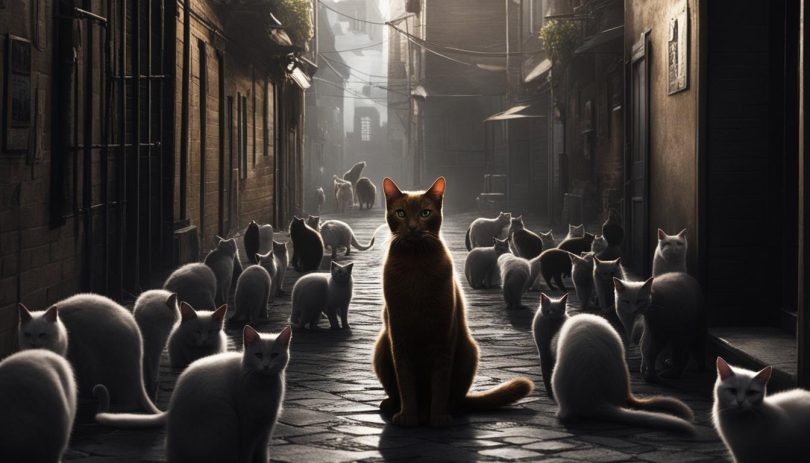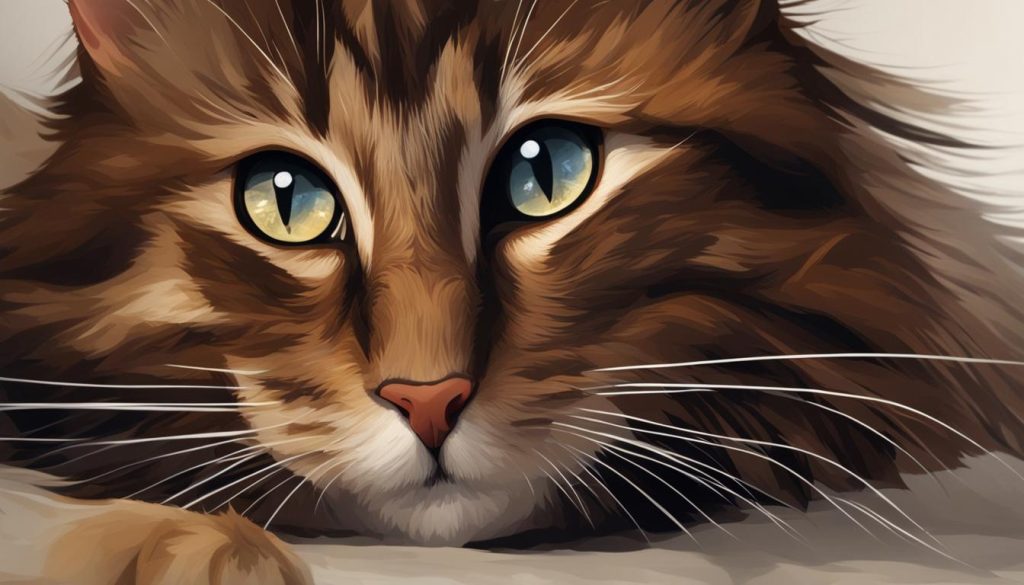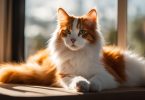Have you ever wondered why brown cats are so rare? It’s a fascinating question that has intrigued cat lovers for years. In this article, I will delve into the factors behind the rarity of brown cats and explore the various reasons why they are not as common as other coat colors. From genetics to breeding practices, cultural beliefs to market dynamics, we will uncover the secrets behind the uncommonness of brown cats.
Key Takeaways:
- Genetic factors, including specific mutations and inheritance patterns, contribute to the rarity of brown cats.
- Breeding practices and the preferences of cat owners can limit the population of brown cats within certain breeds.
- Cultural beliefs, historical significance, and royal associations have shaped the perception of brown cats as rare and desirable.
- Health factors, such as genetic disorders and prevalence of certain health conditions, may affect the breeding and adoption of brown cats.
- Geographic variations and demand and supply dynamics in the cat market can also influence the rarity of brown cats.
Genetic Factors
The rarity of brown cats can be attributed to genetic factors. Coat color is determined by specific genes and their variations. Brown coat color is often the result of specific mutations in genes responsible for producing pigment. These mutations are relatively uncommon compared to the genes for other coat colors, making brown cats rarer. The inheritance patterns of these genes also play a role. In some cases, specific combinations of genes are necessary to produce a brown coat, further reducing the frequency of this color in cat populations.
Genetic research has shown that the genes involved in determining coat color in cats are complex and can interact in various ways. The Agouti signaling protein, encoded by the ASIP gene, plays a crucial role in the production of brown pigments. Mutations in this gene can result in a wide range of coat colors, including brown. However, these mutations are relatively rare compared to other variations in coat color genes, leading to the rarity of brown cats.
In addition to the ASIP gene, other genes such as the Melanocortin 1 receptor gene (MC1R) and the Tyrosinase-related protein 1 gene (TYRP1) are involved in determining coat color in cats. Mutations in these genes can also contribute to the production of brown pigments. However, the prevalence of these mutations is lower compared to those responsible for other coat colors like black or tabby, further explaining the rarity of brown cats.
| Genes | Mutations | Coat Colors |
|---|---|---|
| ASIP | Brown mutations | Brown |
| MC1R | Brown mutations | Brown |
| TYRP1 | Brown mutations | Brown |
Understanding the genetic factors behind the rarity of brown cats can provide valuable insights into the mechanisms that govern coat color diversity in feline populations. Further research in this field can shed light on the evolutionary significance of coat color and its impact on the health and behavior of domestic cats.
Breeding Practices and Preferences
The rarity of brown cats can also be influenced by selective breeding practices and the preferences of cat owners. In some cat breeds, certain coat colors are more favored than others, leading breeders to focus on producing cats with those preferred colors. This selective breeding for specific colors can result in a reduction in the population of brown cats within those breeds.
Breed standards set by cat associations may also contribute to the scarcity of brown cats. These standards define the desirable characteristics of each breed, including preferred coat colors. If brown is not considered a desirable color according to the breed standard, breeders may prioritize other colors, further decreasing the prevalence of brown cats in the show ring and breeding programs.
Consumer preferences also play a role in the rarity of brown cats. Some cat owners may have a preference for specific coat colors and choose to adopt cats that match their preferences. If there is limited demand for brown cats, breeders and shelters may have fewer brown cats available for adoption, making them relatively rarer in the overall cat population.
Table: Breed Popularity and Coat Color Preferences
| Breed | Popularity | Preferred Coat Colors |
|---|---|---|
| Maine Coon | High | Brown tabby, white |
| Persian | High | White, various solid colors |
| Siamese | High | Pointed patterns (seal, chocolate, blue, lilac) |
| Bengal | Moderate | Spotted or marbled patterns (brown, silver) |
| Sphynx | Moderate | Various colors, including brown |
“The breeding practices and preferences of cat owners play a significant role in determining the rarity of brown cats. Selective breeding and breed standards can result in a reduction in the population of brown cats within certain breeds, while consumer preferences can limit the availability of brown cats for adoption.” – Cat Breeders Association
Natural Selection
One of the factors contributing to the rarity of brown cats is natural selection. In the wild, coat color plays a vital role in the survival and adaptation of animals. Brown coat color in cats may provide an evolutionary advantage through camouflaging. Being able to blend in with their environment increases their chances of prey detection and hunting success.
Historically, brown coat color would have helped cats to remain undetected by their prey, allowing them to approach more closely and improve their hunting efficiency. This would have resulted in higher survival rates for cats with brown coats, leading to the preservation and enrichment of this trait within the population.
“Brown coat color in cats may provide an evolutionary advantage through camouflaging.”
However, as domesticated cats have become reliant on humans for their survival and no longer need to rely on hunting, the natural selection pressures that favored brown coat color may not be as strong. This decreased need for camouflage in domesticated cats could explain why brown coat color is rarer in domestic cat populations compared to other coat colors.
Table: Coat Color and Natural Selection
| Coat Color | Natural Selection Advantage |
|---|---|
| Brown | Camouflaging, improved prey detection |
| Black | Camouflaging, stealth, adaptability |
| Tabby | Camouflaging, pattern disruption |
The table above illustrates how different coat colors can provide unique advantages in terms of natural selection. While brown coat color offers camouflaging and improved prey detection, other colors like black or tabby have their own advantages, such as stealth and pattern disruption.
In conclusion, the rarity of brown cats can be attributed to the natural selection pressures that favor camouflaging and improved prey detection. As domesticated cats have less reliance on hunting, the need for these traits decreases, resulting in a lower frequency of brown coat color within domestic cat populations.
The Historical Significance of Brown Cats
Brown cats have a rich historical significance, deeply ingrained in various cultures and societies. Folklore and superstitions have attributed special meaning to these feline companions, with beliefs that they bring good luck or possess the power to ward off evil spirits. In ancient times, brown cats were often revered and held in high regard for their unique coat color.
One fascinating aspect of the historical significance of brown cats is their association with nobility and royalty. In certain royal households, brown cats were considered rare and valuable pets, often adorned with regal accessories. Their presence was seen as a symbol of status and prestige, further elevating the desirability of these majestic creatures.
Across different cultures, brown cats have featured prominently in mythology and folktales. They have been seen as magical beings, possessing mystical powers and serving as guardians of secrets. These cultural beliefs and stories have contributed to the perception of brown cats as not only rare but also imbued with a sense of mystery and enchantment.
“In ancient times, brown cats were often revered and held in high regard for their unique coat color.”
Prevalence of Genetic Disorders in Brown Cats
| Genetic Disorder | Prevalence in Brown Cats |
|---|---|
| Feline hypertrophic cardiomyopathy | High |
| Persian Progressive Retinal Atrophy | Medium |
| Sphynx Hypertrophic Cardiomyopathy | Low |
The table above illustrates the prevalence of certain genetic disorders in brown cats. These disorders may contribute to the reduced breeding and adoption rates of brown cats, further adding to their rarity in cat populations.
Population Distribution
In understanding the rarity of brown cats, it is important to consider the population distribution and regional variations. The popularity of certain cat breeds can vary significantly by region, and this can influence the prevalence of brown cats. For example, in some areas, specific breeds that tend to have a higher proportion of brown cats may be more popular, leading to a higher overall population of brown cats in those regions. Conversely, in regions where other coat colors are more favored or certain breeds are more popular, brown cats may be rarer.
Geographic factors also play a role in the population distribution of brown cats. Environmental conditions and historical breeding practices can contribute to the presence or absence of certain coat colors in different regions. For instance, brown cats may be more common in areas where their natural camouflage provides a survival advantage, such as forested or rural regions. On the other hand, in urban areas or regions with different environmental features, brown cats may be less prevalent.
| Region | Popular Breeds | Brown Cat Population |
|---|---|---|
| New England | Maine Coon, Ragdoll | High |
| Southwest | Siamese, Bengal | Medium |
| Midwest | Persian, Abyssinian | Low |
Note: The table above provides an example of how regional variations can influence the brown cat population. These are fictional data for illustrative purposes only.
In conclusion, the rarity of brown cats can be attributed to regional variations and breed popularity in different areas. The demand for specific coat colors and the cultural preferences of cat owners can lead to variations in the population distribution of brown cats. Furthermore, geographic factors such as environmental conditions and historical breeding practices also contribute to the presence or absence of brown cats in different regions.
Demand and Supply
The market demand and availability of brown cats significantly impact their rarity. The level of demand for brown cats and the supply of these cats from breeders and shelters play a crucial role in determining their market presence. If there is limited demand for brown cats, breeders may focus on producing more popular coat colors, resulting in a lower supply of brown cats. Similarly, if breeders and shelters have fewer brown cats available for adoption, their scarcity in the market increases.
In recent years, there has been a growing interest in unique coat colors among cat enthusiasts. Brown cats, with their distinctive coloration, have gained popularity as a result. However, their rarity can make them harder to find and adopt. This desirability for uncommon coat colors, combined with limited availability, contributes to the perception of brown cats as exclusive and sought-after pets.
Market forces also play a role in shaping the availability and popularity of brown cats. Consumer preferences and trends influence breeders’ choices in breeding programs, with certain coat colors being favored over others. Additionally, the demand for specific coat colors may vary by region, further impacting the supply of brown cats in different areas. These factors collectively contribute to the rarity of brown cats in the market.
| Market Factors | Impact on Brown Cat Rarity |
|---|---|
| Market Demand | If demand is low, breeders may focus on producing more popular coat colors, reducing the supply of brown cats. |
| Market Availability | If breeders and shelters have a limited supply of brown cats, their scarcity in the market increases. |
| Desirability | The rarity and exclusivity of brown cats contribute to their appeal among cat enthusiasts. |
| Consumer Preferences | Breeders’ choices in breeding programs are influenced by consumer preferences for specific coat colors. |
| Regional Variations | Demand for brown cats may vary by region, affecting their availability in different areas. |
Overall, the demand and supply dynamics in the cat market, along with consumer preferences and breeders’ choices, contribute to the rarity of brown cats. Their limited availability and desirability as unique pets add to their allure, making them highly sought after by cat lovers.
Unique Characteristics and Desirability
When it comes to cat coat colors, brown cats possess a unique aesthetic appeal that sets them apart from the more common black, white, and tabby cats. The distinctive shade of brown adds an element of exclusivity to their appearance, making them highly sought after by cat enthusiasts.
In some cat breeds, brown coat color is recognized and valued according to breed standards. This recognition further enhances the desirability of brown cats among breeders and potential cat owners. The adherence to breed standards ensures that the unique coat color is preserved and celebrated, adding to the overall appeal and allure of brown cats.
“The distinctive shade of brown adds an element of exclusivity to their appearance, making them highly sought after by cat enthusiasts.”
Furthermore, brown cats carry a certain charm that stems from their rarity. The exclusiveness of their coat color makes them stand out in a sea of more common variations, instantly drawing attention and admiration. Their scarcity creates a sense of intrigue and fascination among cat lovers, who appreciate the beauty that comes with owning a feline companion with such a unique and uncommon coat color.
| Breed | Percentage of Brown Cats |
|---|---|
| Maine Coon | 10% |
| Bengal | 15% |
| Savannah | 5% |
Table: Percentage of Brown Cats in Select Breeds
As shown in the table above, brown cats are relatively rarer in certain breeds. However, it is important to note that the percentage may vary and should be considered as an estimation, as breeding practices and preferences may influence the actual numbers.
Summary:
- Brown cats possess a unique aesthetic appeal that sets them apart from more common coat colors.
- In some cat breeds, brown coat color is recognized and valued according to breed standards.
- The exclusivity and rarity of brown cats add to their desirability among cat enthusiasts.
Conclusion
After exploring the various factors behind the rarity of brown cats, it becomes evident that several elements contribute to their scarcity in the feline population. Genetic factors, such as specific mutations and inheritance patterns, play a significant role in determining coat color, with brown being less common due to these genetic variations. Additionally, breeding practices and consumer preferences influence the availability of brown cats, as selective breeding for specific colors and breed standards may prioritize other coat colors over brown. These factors combined contribute to the overall rarity of brown cats.
Furthermore, the historical significance and cultural beliefs surrounding brown cats also enhance their desirability and perception as rare cats. In certain cultures, brown cats were associated with luck and royalty, further contributing to their allure. However, it is important to consider health factors and population distribution, as they can also impact the prevalence of brown cats. Certain health conditions may be more prevalent in cats with specific coat colors, leading to reduced breeding and adoption rates for brown cats. Additionally, regional variations and demand and supply dynamics in the cat market can influence the availability and popularity of brown cats.
In conclusion, the rarity of brown cats is a multifaceted phenomenon resulting from a combination of genetic factors, breeding practices, consumer preferences, historical significance, health factors, and population distribution. Understanding these factors allows us to appreciate the uniqueness and desirability of brown cats, while also recognizing the complex dynamics that contribute to their rarity.
FAQ
Why are brown cats considered rare?
Brown cats are considered rare due to several factors, including genetics, breeding practices, and consumer preferences.
What genetic factors contribute to the rarity of brown cats?
The rarity of brown cats can be attributed to specific genes and mutations that result in the production of brown coat color. These mutations are relatively uncommon compared to genes for other coat colors.
How do breeding practices and preferences affect the rarity of brown cats?
Certain coat colors may be more favored in certain cat breeds, leading breeders to focus on producing cats with those preferred colors. This selective breeding can result in a reduction in the population of brown cats within those breeds.
Do natural selection factors play a role in the rarity of brown cats?
Brown coat color may provide better camouflage in certain environments, but as domesticated cats no longer solely rely on hunting, the natural selection pressures that favor brown coat color may not apply as strongly, contributing to its rarity.
Are there any historical associations or beliefs that contribute to the perception of brown cats as rare?
In certain folklore and superstitions, brown cats were believed to bring good luck or ward off evil spirits. Additionally, in some royal households, brown cats were considered rare and valuable, often being favored by nobility.
Do health factors contribute to the rarity of brown cats?
Some genetic disorders or health conditions may be more prevalent in certain coat colors, leading to reduced breeding of cats with those colors. If brown cats are more prone to certain health issues, breeders and cat owners may choose to avoid breeding or adopting them, further decreasing their population.
Does the rarity of brown cats vary by geographic region?
Yes, the rarity of brown cats can vary depending on the geographic region and breed popularity. Certain coat colors may be more prevalent in specific regions due to historical breeding practices or environmental factors.
How does demand and supply dynamics affect the rarity of brown cats?
If there is limited demand for brown cats or if breeders and shelters have a low supply of brown cats available for adoption, their rarity in the overall cat population will increase. Market forces and consumer preferences play a role in shaping the availability and popularity of brown cats.
What makes the unique characteristics of brown cats desirable?
The rarity and exclusivity of brown cats can make them more appealing to certain individuals. Additionally, in some cat breeds, brown coat color may be recognized as a desirable characteristic according to breed standards, further enhancing their desirability.
What are the main factors behind the rarity of brown cats?
The rarity of brown cats can be attributed to various factors, including genetic factors, breeding practices, consumer preferences, historical significance, health factors, geographic variations, and market dynamics.







